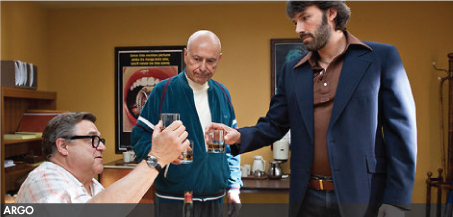
ARGO: THIS FILM’S NO PHONY
|
With ARGO, the new release from Warner Bros. Pictures and GK Films set during the 1979-80 Iran hostage crisis, Director Ben Affleck (GONE BABY GONE, THE TOWN) escapes the old Boston neighborhood that defined his first two films and moves onto the global stage. The thriller is set in Washington, DC, Hollywood and Tehran, but like Affleck’s earlier directorial efforts, the story centers on ordinary people whose faith and loyalties are tested when they are asked to make tough decisions and find the courage to risk their lives. The plot of ARGO derives from the so-called “Canadian Caper,” when a group of American diplomats, hiding in the home of the Canadian Consul in Tehran following the takeover of the U.S. Embassy by student radicals, pretended to be Canadian filmmakers in order to escape. A bearded Affleck plays Tony Mendez, the CIA “exfiltration” expert who created the plot to get the Americans out of the country. Chris Terrio, a New Yorker who studied film at USC’s School of Cinematic Arts and wrote the screenplay for ARGO based on an article by Joshuah Bearman, had the opportunity to meet the real-life Tony Mendez. “He lives in rural Maryland on the border of Virginia, sort of Civil War country…and I spent a couple of days with him,” Terrio recalled. “I always like to have a pretty good idea of what I think the character is just from my own imagination and then go meet the person afterward,” he explained. Terrio considers himself generally suspicious of people, especially people the CIA or the military calls heroes. “But I went down there and I really found Tony to be smart…and he had a great sense of humor. His version of going to work is taking off your wedding ring, getting on a plane, taking a false passport and flying off into the unknown. And it wasn’t a James Bond, sleek, sexy version of it; it was more like a good man doing his job. After I met Tony I tried to make the CIA more of a workaday world.” The true story upon which ARGO is based involved the creation of a phony sci-fi film (“ARGO”) by a bogus production company used to trick Iranian officials. “If I’m doing a fake movie, it’s going to be a fake hit,” says Alan Arkin as Lester Siegel, the veteran producer pressed into service by the CIA. In today’s ARGO, Affleck has made a real movie about the making of a fake movie with life-and-death consequences for the imperiled diplomats. How fitting that Affleck, the director, has escaped a potential “Boston specialist” pigeonhole through a movie about an escape. Escape movies have been a film staple since the days of HALDANE OF THE SECRET SERVICE (1923) starring Harry Houdini. Film historian and critic Leonard Maltin named THE GREAT ESCAPE (1963) and STALAG 17 (1953) among his favorites of the genre. “Who couldn’t identify with the dilemma of someone trying to escape from confinement, especially when your jailors are Nazis,” said Maltin. “It’s a natural set-up for rooting interest.” Substitute Iranian extremists for German Nazis and you have a strong rooting interest in ARGO. But Terrio sees the situation as more complex.
“We wanted to…present a more sensitive version of the crisis and a more complicated version,” said the screenwriter. “It started off as a very idealistic movement. It was students, many of whom studied at Berkeley and at American universities and were trained in things like sit-ins and peaceful resistance. Many of the students in the initial movement in Iran were idealists who wanted to bring about peaceful change and then, as happens with many or most revolutions, those people were co-opted by the extremists.” “Ben is the genetically engineered perfect director for this,” said Terrio. “Because his major was Middle Eastern studies in college, he obviously knows a lot about that part of the world and did long before we ever started together on this, and has obviously had years of experience in Hollywood, and has done things like appeared in espionage movies and has a good feeling on what the CIA is.” |
“On the other hand, you don’t immediately think Ben Affleck is going to direct a Hollywood-slash-CIA movie,” the writer continued. “But I think what Ben brings is not only his intelligence and his sophistication about moviemaking but…a vulnerability. I think he has a big heart. This movie wouldn’t work if it were some smug, nudge-wink film about Hollywood and putting one over on the Iranians. It’s about people in difficult situations trying to do their best.” Affleck was eight years old and Terrio three when 52 blindfolded Americans were paraded before the world media by Iranian students – among them Mahmoud Ahmadinejad, current President of the Islamic Republic of Iran. One wonders if young Benjamin Géza Affleck-Boldt was allowed to stay up to watch ABC’s NIGHTLINE with Ted Koppel, the show that extended America’s news day and saw its ratings soar in 1980 as it counted off the days of the crisis.
Terrio was too young to remember the Iran hostage crisis first-hand. “My father was a Marine,” he said. “I was kind of aware of it growing up. People would always refer to the hostages. Ben was about the age of Tony Mendez’s son in the movie. So essentially when you see the STAR WARS bedroom of Tony Mendez’s son, that’s my bedroom and Ben’s bedroom. I mean we both had the same pillowcase in our beds.” When he was chosen to write the script, Terrio read everything that he could about Iran. “I went to the Paley Center [formerly The Museum of Television & Radio] and looked at everything that they had about the hostage crisis, which was hours and hours and hours of NIGHTLINE and news reports,” he recalled. “Thinking about amped-up men who could talk themselves into or out of any situation…I began to see the parallel between the espionage world – CIA, government – and then the Hollywood side.” In addition to Affleck, ARGO stars Bryan Cranston (BREAKING BAD) and John Goodman (THE ARTIST). “He casts well,” said Maltin, who named THE TOWN his favorite film of 2010. “I think his intelligence permeates every aspect of the films he makes. He’s a bright guy and it shows.” As for Affleck leaving his comfort zone of “the old neighborhood,” the “Bah-stin” accents and Fenway “Pack,” Maltin added, “Affleck has made excellent use of his intimate knowledge of greater Boston, but I see no need for him to become a prisoner there.” Does Terrio see parallels between Affleck’s other films and ARGO? “We had to stake out a new tone of our own with this one,” he said. “But what excited me was that, after seeing his other films I thought, ‘this is a guy that I can learn from and whose decisions I respect.’ I think one similarity is it’s a humanist story, but there’s an undercurrent of violence and danger.” “I admire anybody who can get a movie made,” said Maltin. “It’s harder to do than ever. I especially admire someone who has a point of view or has his personal passion involved. That’s why I’m rooting for Ben Affleck and this film.” As for Terrio, the future holds two new projects – one based on a true story published in the New Yorker about a UN lawyer and political assassinations in Guatemala, the other an original crime story he’s developing for director Paul Greengrass (THE BOURNE SUPREMACY). The screenwriter is pleased with how ARGO has turned out. “I was on set for most of it and I’ve hung around post-production,” he explained. “I’ve been feeling like I’ve hit the lottery at every step of the way on this one.” ARGO arrives in theaters on October 12. |

|
|
Stuntman Bud Ekins, a close friend of and double for actor Steve McQueen, performed what became an iconic action film stunt in THE GREAT ESCAPE: the motorcycle jump over a six-foot-wide wooden fence as Hilts (McQueen) attempts to cross the Swiss border. For insurance reasons, McQueen was not allowed to make the jump, but did perform other elements of the biking sequences, including doubling as the German cyclist chasing Hilts. The star’s former wife, Neile McQueen Toffel, stated in her memoir that if she were to select a moment in McQueen’s career that launched him into international stardom, it was the cycle jump, which for many years was credited to the actor, not Ekins. In a mid-1970s interview, Ekins confirmed that he did the jump, for which he was paid $750, and also that he was hired to create the motorcycles used in the sequence, which he constructed from new British bikes modified to resemble World War II-era German vehicles. THE GREAT ESCAPE marked Ekins’ first feature film work, after which he went on to work as an actor and stuntman in numerous other pictures, including McQueen’s 1968 hit movie BULLITT. For more on THE GREAT ESCAPE visit the AFI Catalog of Feature Films. |


